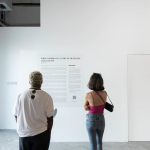‘All human desire is poised on an axis of paradox, absence and presence its poles, love and hate its motive energies’ – AnneCarson, Eros the Bittersweet (1986).
In her seminal book Eros the Bittersweet, Anne Carson explores the multidimensional possibilities and intricacies of desire. Through a philosophical and poetic analysis of the Ancients – Aristophanes, Socrate and others – the Canadian poet, essayist, translator, and classicist reflects on the paradox of love that ultimately results in what Greek poet Sappho coined as glukupikron (‘bittersweet’) love. As Carson puts it, twisting the famous Cogito ergo sum, or ‘I think therefore I am’, of René Descartes: Odi et amo ergo, or ‘I love and hate, therefore I am’.
Just as desire is at the core of Carson’s book, it is at the core of Aidha Badr’s new solo exhibition whose title, ‘When I Desire You A Part Of Me Is Gone’, is a line directly borrowed from Eros the Bittersweet. Yet, it is not its sole romantic facet that the artist seeks to understand; rather, she seeks to untangle the roots of female desire by using memory as a medium and exploring theories of attachment.
At the beginning, there was the mother. Following the work of Nancy Kulish and Deanna Holtzman on ‘The Persephone Complex’, or the intricacies of the daughter-mother relationship, Aidha Badr scrutinizes the way the mother figure and its representations play a significant role in childhood and the early stages of a girl’s development. Her Cloth Was Cut From Heaven, She Wished To Be Me And I Wished To Be Her (2021) depicts the attachment of the young girl to her doll. By taking care, dressing, undressing, and cuddling the doll, the little girl replays the role of the mother, thus subconsciously constructing a strict set of beliefs about what a woman essentially is and what she must become through this process.
In this painting, the abstract motherly figure holds a small, distant red sun between her fingers. This recurring motif in Aidha Badr’s work comes from the song her doll would automatically sing You Are My Sunshine by Johnny Cash after pressing the button on her stomach. The iteration of the red sun from one painting to another highlights the way the past intertwines with the present and how a memory – whether it is of an object, a place, or a person – can lastingly infuse and shape one’s memory.



